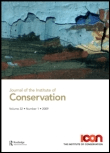
Journal of the Institute of Conservation
Scope & Guideline
Uniting Experts in the Quest for Effective Conservation
Introduction
Aims and Scopes
- Interdisciplinary Research in Conservation:
The journal emphasizes the integration of various disciplines, including science, art history, and cultural studies, to enhance conservation practices and methodologies. - Scientific Approaches to Conservation:
It showcases studies that apply scientific methods to understand the materials and techniques used in artworks and artifacts, leading to improved conservation strategies. - Cultural Heritage Policy and Ethics:
The journal addresses the ethical considerations and policy implications surrounding cultural heritage conservation, focusing on inclusive practices and decolonization efforts. - Innovative Conservation Techniques:
It features research on new conservation techniques and materials, including case studies that demonstrate effective applications in real-world scenarios. - Community Engagement and Education in Conservation:
The journal highlights projects that involve community participation in conservation efforts, emphasizing the importance of education and awareness in preserving cultural heritage.
Trending and Emerging
- Decolonization of Conservation Practices:
There is a growing focus on decolonizing conservation education and practices, emphasizing the need to include diverse cultural perspectives and address historical injustices within the field. - Climate Change and Environmental Impact:
Recent studies are increasingly addressing the impacts of climate change on cultural heritage, highlighting the urgency of adapting conservation practices to mitigate environmental threats. - Community Resilience and Disaster Preparedness:
Research is trending towards building community resilience and integrating disaster preparedness into conservation strategies, particularly in response to recent global crises. - Technological Innovations in Conservation:
The journal is witnessing an uptick in papers exploring the use of advanced technologies, such as digital imaging and AI, to enhance conservation practices and documentation. - Interdisciplinary Collaborations:
There is an emerging trend of collaborative projects that involve partnerships between conservators, scientists, and artists, fostering innovative solutions to complex conservation challenges.
Declining or Waning
- Traditional Conservation Methods:
There has been a noticeable decline in publications focused solely on traditional conservation methods, as the field increasingly embraces innovative and interdisciplinary approaches. - Historical Case Studies:
Although historical perspectives remain important, fewer papers are dedicated to purely historical case studies without a direct link to contemporary conservation practices. - Regional Focus on Western Heritage:
Research centered exclusively on Western cultural heritage seems to be waning, possibly due to a growing emphasis on global perspectives and the conservation of diverse cultural contexts. - Material-Specific Studies:
There is a trend away from studies that focus narrowly on specific materials (e.g., paper, textiles) without broader implications for conservation, as interdisciplinary approaches gain traction. - Conservation Theory without Application:
Papers discussing conservation theory without practical application or case studies are becoming less common, as the field prioritizes actionable insights and methodologies.
Similar Journals
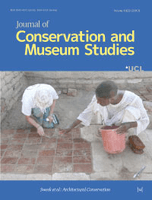
Journal of Conservation and Museum Studies
Bridging Theory and Practice in Cultural PreservationThe Journal of Conservation and Museum Studies, published by UBIQUITY PRESS LTD, is a vital resource for researchers, professionals, and students engaged in the fields of conservation and museology. With an ISSN of 2049-4572 and an E-ISSN of 1364-0429, this Open Access journal has been committed to disseminating quality research since its inception in 2011. Based in the United Kingdom, the journal features a broad range of topics within its field, serving both theoretical and practical insights for the advancing of conservation practices and museum studies. The journal is highly regarded, standing in the Q2 quartile for both Conservation and Museology categories in 2023, and achieving commendable rankings in the Scopus classification, with a percentile rank of 86th in Museology and 76th in Conservation. This demonstrates its significance as a hub for scholarly communication and innovation, fostering a deeper understanding and appreciation of cultural heritage. Join a diverse community of experts and access cutting-edge research in the field by engaging with this essential journal.
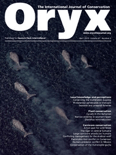
ORYX
Fostering Collaboration in Ecology and EvolutionORYX, published by Cambridge University Press, stands as a prestigious scholarly journal in the fields of Ecology, Evolution, and Conservation. With an ISSN of 0030-6053 and E-ISSN 1365-3008, this journal has been a critical platform for researchers and professionals since its inception in 1950. Recognized for its excellence, ORYX ranks in the Q1 quartile for both Ecology, Evolution, Behavior and Systematics and Nature and Landscape Conservation as of 2023, highlighting its influential contributions to the field. With a strong focus on disseminating innovative research and fostering collaboration among scientists, the journal covers a broad array of topics, from biodiversity and ecosystem services to conservation strategies and policy implications. As a result, ORYX provides invaluable insights that help shape the future of environmental science. Its impressive Scopus rankings place it in the top 80th percentile in its categories, further underscoring its importance and appeal among academics, professionals, and students alike.
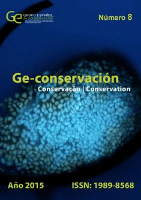
Ge-Conservacion
Uniting Disciplines for a Sustainable Cultural LegacyGe-Conservacion, published by GRUPO ESPANOL I I C, stands as a pivotal journal in the fields of Conservation, Museology, and Visual Arts and Performing Arts, facilitating an open-access platform since 2009. Based in Spain, this journal serves as a vital repository for innovative research and scholarly dialogue, significantly impacting the community with its Q1 and Q2 rankings across several categories in 2023. With an objective to advance multidisciplinary understanding and practices related to cultural heritage conservation, it attracts a diverse readership of researchers, professionals, and students eager to engage with contemporary issues and methodologies. The journal's commitment to accessibility enhances its reach and influence, making it an essential resource for anyone passionate about preserving the integrity and significance of our artistic and historical treasures.
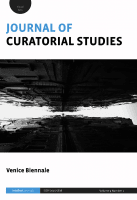
Journal of Curatorial Studies
Charting New Territories in Visual Arts and MuseologyThe Journal of Curatorial Studies, published by INTELLECT LTD, is a leading scholarly journal dedicated to advancing the field of curatorial practice across the visual arts, museology, and conservation. With an ISSN of 2045-5836 and an E-ISSN of 2045-5844, this UK-based publication has been a vital resource since its establishment in 2016, covering significant developments and innovative research until 2023. As an academic platform, it seeks to foster interdisciplinary dialogue among curators, artists, and scholars, exploring contemporary challenges and methodologies within its scope. Ranking in the Q4 category for Conservation and Q3 for both Museology and Visual Arts and Performing Arts, the journal plays an essential role in elevating discourse and practice within these fields. Researchers and practitioners alike will find valuable insights that reflect the dynamic nature of curatorial studies and its profound influence on cultural heritage and contemporary art. Despite its recent establishment, it holds a commendable position in the Scopus Rankings, aiming to provide a rich repository of knowledge and practical guidance in its quest to innovate curatorial practices.

Revista Eletronica Ventilando Acervos
Exploring the Frontiers of Archival ScienceRevista Eletronica Ventilando Acervos, with ISSN 2318-6062, is a pioneering academic journal published by the esteemed MUSEU VICTOR MEIRELLES-IBRAM, dedicated to the exploration and dissemination of research in the field of archival studies, museum studies, and heritage conservation. As an open-access journal, it provides unrestricted access to a wealth of scholarly articles, promoting the sharing of knowledge and innovative practices among researchers, professionals, and students alike. Situated in Florianópolis, Brazil, the journal not only showcases local research but also contributes to global discourse on cultural heritage and information management. With a vision to foster collaboration and dialogue within the academic community, Revista Eletronica Ventilando Acervos plays a pivotal role in enriching our understanding of archival science and its impact on society, making it an invaluable resource for anyone engaged in this dynamic field.
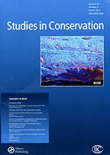
STUDIES IN CONSERVATION
Connecting Scholars to Drive Conservation ForwardSTUDIES IN CONSERVATION, published by Routledge Journals, Taylor & Francis Ltd, stands as a premier peer-reviewed journal in the field of conservation, holding a distinguished Q1 ranking in the Conservation category for 2023. With its origins dating back to 1952 and poised to continue through 2024, this respected journal provides a vital platform for disseminating high-quality research and innovative practices aimed at the preservation of cultural heritage and natural environments. The journal boasts an impressive Scopus rank of #15 out of 103 within its category, reflecting its influential role in shaping the dialogue among researchers, professionals, and students dedicated to conservation efforts. While Open Access options are not currently available, the journal remains accessible to a broad readership eager to engage with its in-depth analyses and critical studies that address urgent conservation challenges. The editorial team seeks to promote diverse perspectives and foster interdisciplinary collaboration, making STUDIES IN CONSERVATION an essential resource for anyone committed to advancing the field of conservation.

MUSEOLOGIA SCIENTIFICA
Fostering Collaboration in the World of MuseologyMUSEOLOGIA SCIENTIFICA is a distinguished journal dedicated to the study and advancement of museology, published by the ASSOCIAZIONE NAZIONALE MUSEI SCIENTIFICI in Italy. Focusing on a wide array of topics within the realm of science museums, the journal offers rich insights and research findings that shape the future of museum practices and education. Although currently not an open-access publication, MUSEOLOGIA SCIENTIFICA provides a vital platform for scholars, practitioners, and students interested in the preservation, curation, and display of scientific artifacts. By contributing to the discourse on innovative museum practices, the journal plays a crucial role in enhancing the professional standards within the field while promoting collaboration among museums worldwide. We invite researchers and practitioners alike to explore its valuable content, aimed at broadening understanding and knowledge in the ever-evolving landscape of museology.
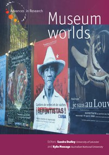
Museum Worlds
Elevating research in the evolving landscape of museums.Museum Worlds is a distinguished academic journal published by BERGHAHN JOURNALS, dedicated to advancing scholarship in the fields of Museology and Conservation. With a strong impact within the academic community, evidenced by its 2023 Scopus rankings—#16 in Museology and #32 in Conservation—this journal offers an engaging platform for innovative research and discourse surrounding museum practices and cultural heritage. Since transitioning to Open Access in 2020, Museum Worlds has broadened its reach, making valuable insights available to researchers and practitioners globally. With its publication spanning from 2019 to 2023 and positioning in the top quartiles of respective categories, this journal is integral for those invested in the evolution of museum studies, providing a space for critical reflection, debate, and the sharing of pioneering methodologies in the stewardship of cultural institutions. Located in the heart of Brooklyn, NY, it stands as a hub for the scholarly community, inviting contributions that push the boundaries of knowledge in the ever-evolving landscape of museums.

Quiroga-Revista de Patrimonio Iberoamericano
Celebrating Ibero-American Heritage Through Innovative ResearchQuiroga-Revista de Patrimonio Iberoamericano, published by UNIV GRANADA, is a distinguished open-access journal dedicated to the fields of conservation, museology, and the visual and performing arts. Since its inception in 2012, the journal has provided a platform for scholars and practitioners to disseminate innovative research and critical discussions pertinent to Ibero-American heritage. With a growing impact, evidenced by its category quartiles ranking—Q3 in Conservation and Q2 in both Museology and Visual Arts and Performing Arts—as well as its Scopus rankings, Quiroga serves as an essential resource for researchers, professionals, and students who engage with the complexities of cultural preservation and artistic expression. The journal’s commitment to open access ensures the widespread availability of knowledge, fostering academic dialogue and collaboration within the global community. For inquiries, the journal can be reached at their offices located in Granada, Spain.

International Journal of Intangible Heritage
Advancing the Dialogue on Intangible Heritage.The International Journal of Intangible Heritage, published by the NATL FOLK MUSEUM KOREA-NFMK, stands as a premier platform dedicated to the exploration and preservation of intangible cultural heritage. With an ISSN of 1975-3586 and an E-ISSN of 1975-4019, this journal has successfully carved a niche in the fields of Conservation, Cultural Studies, and Museology, achieving Q1 categorization across these disciplines in 2023. It ranks impressively in Scopus, being #17/83 in Museology and #33/103 in Conservation, highlighting its significant contribution to the academic discourse in these fields. Published in South Korea, this journal not only serves as a vital resource for researchers and professionals but also engages students aspiring to enhance their understanding of intangible heritage. Accessible without an open access model, it features a blend of scholarly articles, reviews, and case studies from 2011 through 2024, making it a robust repository for current and emerging practices in the safeguarding of cultural expressions. By fostering innovative dialogue among scholars and practitioners globally, the International Journal of Intangible Heritage plays a crucial role in the ongoing dialogue surrounding the value and significance of intangible cultural assets.